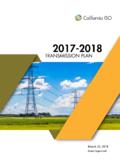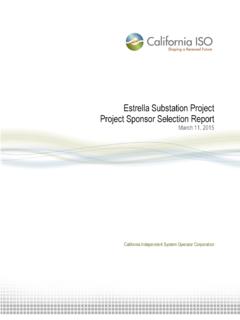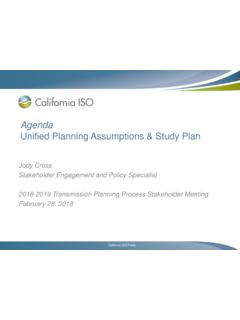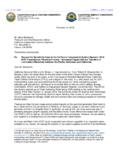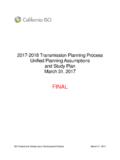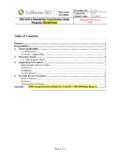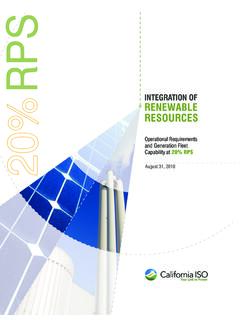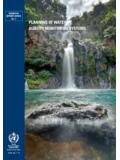Transcription of Annual Interregional Information 2017-2018 …
1 California ISO Public California ISO PublicAnnual Interregional Information2017- 2018 Transmission planning ProcessAnnual Interregional Coordination MeetingFolsom, CAFebruary 22, 2018 California ISO Public California ISO PublicIntroduction and OverviewDraft 2017 - 2018 Transmission Plan and transmission project approval recommendationsCalifornia ISO Public 2017 - 2018 Transmission planning ProcessMarch 2018 April 2017 January 2017 State and federal policyCEC -Demand forecastsCPUC -Resource forecasts and common assumptions with procurement processesOther issues or concernsPhase 1 Develop detailed study planPhase 2 -Sequential technical studies Reliability analysis Renewable (policy-driven) analysis Economic analysis Publish comprehensive transmission plan with recommended projectsISO Board for approval of transmission planPhase 3 ProcurementDraft transmission plan presented for stakeholder ISO Public 2017 - 2018 Ten Year Plan Milestones Preliminary reliability study results were posted on August 15 Stakeholder session September 21st and 22nd Comments received October 6 (slow response resource special study extended to October 10)
2 Request window closed October 15 Preliminary policy and economic study results and update on other issues November 16 Comments received November 30 Draftplan posted February 1, 2018 Comments due February 22 Revised draft for approval at March Board of Governor meetingPage 4 California ISO Public planning and procurement overviewCreate demand forecast & assess resource needsCEC &CPUCWith input from ISO, IOUs & other stakeholdersCreates transmission planISOWith input from CEC, CPUC, IOUs & other stakeholdersCreates procurement planCPUC123feed intoWith input from CEC, ISO, IOUs & other stakeholders4 IOUsFinal plan authorizes procurement Results of 2-3-4 feed into next biennial cycle feed intoCalifornia ISO Public Slide 6 Development of 2017 - 2018 Annual Transmission PlanReliability Analysis(NERC Compliance)33% RPS Portfolio Analysis-Incorporate GIP network upgrades-Identify policy transmission needsEconomic Analysis-Congestion studies-Identify economic transmission needsOther Analysis(LCR, SPS review, etc.)
3 ResultsCalifornia ISO Public Emphasis in the transmission planning cycle: A modest capital program, as: Reliability issues are largely in hand, especially with load forecasts declining from previous years and behind the meter generation forecasts increasing from previous projections Policy work was largely informational as we await actionable renewable portfolio policy direction regarding moving beyond 33% (for approvals) Modestly-sized economic driven projects emerging as evolving industry circumstances create some new opportunities A major effort in this third and final year of the programmatic review of previously-approved projects Preferred resources and transmission upgrades playing a critical role in the integrated solutions in several areas Emerging issues continuing to drive re-thinking on how we study and assess transmission system issuesPage 7 California ISO Public Consideration of the impacts of behind the meter photovoltaic generation on load shapes and shifting the time of load peaks to later in the day is evolving: In CED 2015 (2016-2026 Forecast), the CEC determined peak loads through downward adjustments to the traditional mid-day peak loads and acknowledged the issue of later-day peaks.
4 In the 2016- 2017 planning cycle the ISO conducted is own sensitivities In CEDU 2016 ( 2017 -2027), the CEC provided sensitivities of later day peaks. The ISO used those sensitivities in this 2017 - 2017 planning cycle to review previously-approved projects, but not as the basis for approving new projects Through CED 2017 ( 2018 -2028) the ISO is anticipating hourly load shapesPage 8 California ISO Public The ISO s reliability analysis led to the following:Page 9 12 new reliability projects are recommended firming up the February 1 posted plan In the PG&E service territory ,19 previously-approved projects are recommended to be canceled and 21 have been re-scoped, paring over $ billion from current estimates. 6 have been identified as needing further review Two previously-approved projects in the SDG&E service territory are recommended to be canceled California ISO Public Policy-driven analysis for approval purposes was not needed -no policy-driven approvals are recommended Portfolio direction received from the CPUC and CEC on June 13, 2016.
5 Recommend reusing the "33% 2025 Mid AAEE" RPS trajectory portfolio that was used in the 2015-16 TPP studies, as the base case renewable resource portfolio in the 2016-17 TPP studies Given the range of potential implementation paths for a 50 percent RPS, it is undesirable to use a renewable portfolio in the TPP base case that might trigger new transmission investment, until more Information is available This policy direction remained in place for the 2017 - 2018 transmission planning cycle Portfolios used in the ISO s informational 50% RPS special studies and evaluation of Interregional projects were provided by CPUC staffPage 10 California ISO Public The ISO is recommending a number of economic-driven projects: One in the VEA service territory provides production simulation benefits One in the Imperial Valley area provides both local capacity requirement reduction benefits and production simulation benefits Two in the East Bay/Moss Landing Sub-area focus on reducing local capacity requirements in the areaSlide 11 California ISO Public Status of proposal to add Phasor Measurement Units (PMUs) to all CAISO Interties.
6 In November 2017 , the ISO introduced the proposal that PMUs be added to all ISO intertie transmission faculties to other balancing areas Phasor measurement units will enhance accuracy of measurements to demonstrate compliance with NERC Reliability Standard The ISO must meet frequency response obligation based on net actual interchange measurements The ISO is continuing to refine the scope of the effort and will bring forward a recommendation in the futurePage 12 California ISO Public Special studies performed as part of the 2017 - 2018 planning process will help inform future studies The six special studies conducted in 2017 have been summarized in the 2017 - 2018 Transmission Plan Interregional Transmission Project (ITP) Evaluation and 50% RPS Out-of-State Portfolio Assessment (extension of 2016- 2017 studies) Risks of early economic retirement of gas fleet (extension of 2016- 2017 studies) Benefits analysis of large energy storage (extension of 2016- 2017 studies) Frequency response assessment Gas/Electric coordination special study Characteristics of slow response local capacity resourcesPage 13 California ISO Public The ISO Board has approved the proposal to remove the conceptual statewide plan requirement Since 2010, the ISO has prepared and published the statewide plan as part of its Annual planning process, initially developed to facilitate coordination with the California Transmission planning Group (CTPG) Implementation of FERC Order No.
7 1000 has supplanted the need to develop the statewide plan CTPG is no longer functioning and its members are focused on regional planning through Order 1000 The statewide plan no longer facilitates the coordination function it was intended to provide ISO developing the plan on its own diverts resources away from Order 1000 activities After an ISO stakeholder process in May and June, the ISO Board approved the proposal on July 26. The change was filed with FERC on August 26 and we are awaiting a decisionSlide 14 California ISO Public California ISO PublicEconomic AssessmentDraft 2017 - 2018 Transmission Plan and transmission project approval recommendationsCalifornia ISO Public Overview of economic planning methodology ISO s economic planning study follows the updated TEAM documentation updated in 2017 Study approach:Page 16 Power System analyses (production cost simulation, power flow studies, etc.)
8 With and without network upgrade under studyProduction benefitsOther benefitsTotal benefitsBenefit to cost ratio (BCR)Total cost (revenue requirement) estimation and calculationCalifornia ISO Public Database development with more accurate representation of network models Identical network models for the ISO system in PCM and in the reliability power flow cases Transmission topology, generator location, load distribution Load modifiers were modeled as generators at the locations as in power flow cases Coordinated with other regions to update their system models Most recently updated operational data and models Updated solar profiles (in collaboration with WPR ADS process) with higher granularity based on NREL measurements Updated thermal unit ramp rates based on industry average IV PFC dispatchablePage 17 Overview of ISO s planning PCM development and enhancement (cont.)
9 California ISO Public Summary and recommendationsCongestion or study areaProduction benefit ($M)Capacity benefit ($M)Estimated total cost ($M)Economic justificationS-Line4085~11046~72 YesBobSS-MeadS180 Not applicable37 YesSanDiegoNorth27 Not applicable101~116 NoSouth Bay-Moss Landing areaNot applicable400-600 MW LCR benefit$14 YesPage 18 Four upgrades were found to be needed as economic-driven projects in the 2017 - 2018 planning cycle:-S-Line Upgrade-Bob SS to Mead S 230 kV Line Upgrade, -South Bay-Moss Landing enhancements comprising of the San Jose-Trimble 115 kV series reactor and the Moss Landing Panoche230 kV Path UpgradeCalifornia ISO Public California ISO PublicSpecial Study Frequency Response Assessment-Generation ModelingCalifornia ISO Public Frequency Response Studies Frequency response studies performed in the previous Transmission Plans showed optimistic results Actual measurements of the generators output were lower that the generators output in the simulations Therefore models update and validation is needed After improvement of models, more frequency studies will be performed Slide 20 California ISO Public Update of Generator Models The ISO reviewed.
10 And identified issues with dynamic stability models for multiple units Issues Missing models Suspicious models Models with generic parameters Models no longer approved by WECC Currently working with the PTOs to get results from generator testing and improve the models Challenges: Challenges in getting fully validated models from generation owners Difference between NERC Standards and WECC Policy on generator testingSlide 21 California ISO Public Standards on Generator Testing NERC dynamic data related compliance (MOD-26 and MOD-27) applies to the following to Western Interconnection Individual generating unit greater than 75 MVA (gross nameplate rating) Individual generating plant consisting of multiple generating units that are directly connected at a common BES bus with total generation greater than 75 MVA (gross aggregate nameplate rating) WECC Policy applies to Generating facilities connected to the Western Electricity Coordinating Council (WECC) transmission grid at 60 kV or higher voltage (both new and existing, synchronous and non-synchronous)
